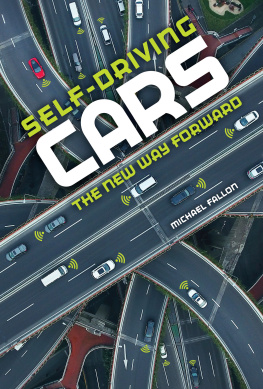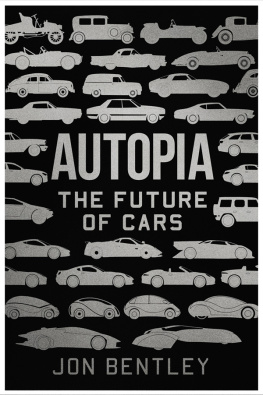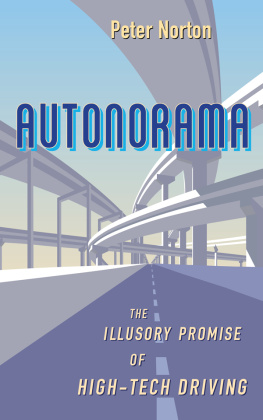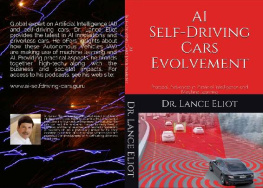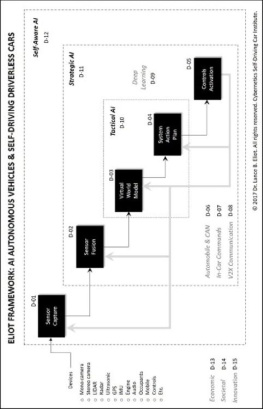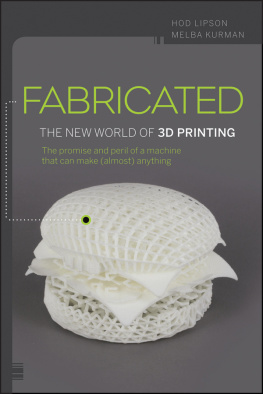Driverless
Intelligent Cars and the Road Ahead
Hod Lipson and Melba Kurman
The MIT Press
Cambridge, Massachusetts
London, England
2016 Massachusetts Institute of Technology
All rights reserved. No part of this book may be reproduced in any form by any electronic or mechanical means (including photocopying, recording, or information storage and retrieval) without permission in writing from the publisher.
This book was set in Century Schoolbook and Gotham by Toppan Best-set Premedia Limited. Printed and bound in the United States of America.
Library of Congress Cataloging-in-Publication Data
Names: Lipson, Hod, author. | Kurman, Melba, author.
Title: Driverless : intelligent cars and the road ahead / Hod Lipson and Melba Kurman.
Description: Cambridge, MA : The MIT Press, [2016] | Includes bibliographical references and index.
Identifiers: LCCN 2016012608 | ISBN 9780262035224 (hardcover : alk. paper)
eISBN 9780262336635
Subjects: LCSH: Automobiles--Automatic control. | Autonomous vehicles. | Autonomous vehicles--Social aspects. | Autonomous vehicles--Environmental aspects. | Traffic safety--Technological innovations.
Classification: LCC TL152.8 .L57 2016 | DDC 388.3/42--dc23 LC record available at https://lccn.loc.gov/2016012608
ePub Version 1.0
The publisher and the authors make no representations or warranties with respect to the accuracy or completeness of the contents of this work and specifically disclaim all warranties, including without limitation warranties of fitness for a particular purpose. No warranty may be created or extended by sales or promotional materials. The opinions, advice, and strategies contained herein may not be suitable for every situation. This work is sold with the understanding that the publisher is not engaged in rendering legal, accounting, or other professional services. If professional assistance is required, the services of a competent professional person should be sought. Neither the publisher nor the authors shall be liable for damages arising herefrom. The fact that an organization or website is referred to in this work as a citation and/or a potential source of further information does not mean that the authors or the publisher endorses the information the organization or website may provide or recommendations it may make. Further, readers should be aware that Internet websites listed in this work may have changed or disappeared between when this work was written and when it is read.
Preface
The mundane automobile is about to disrupt your life. Thanks to rapid advances in mobile robotics, cars are poised to morph into the first mainstream autonomous robots that we will entrust with our lives. After almost a century of failed attempts to automate driving, modern hardware technology, and a new generation of artificial-intelligence software called deep learning, are giving cars human-level ability to safely guide themselves through unpredictable environments.
We wrote this book to tell the story of this revolution. We found ourselves drawn to driverless cars for two reasons. First, we keep a close eye on potentially disruptive new technologies, and driverless cars promise to be one of the most game-changing new machines well encounter in our lifetimes. The second reason was more personal. Like most people, we drive an hour or two a day in all kinds of weather, frequently with precious cargokids, friends, and petson board. Yet, if it were possible, we would prefer to drive, but without having to sit behind the steering wheel ourselves. When Googles driverless cars started making real progress a few years ago, needless to say, we paid close attention.
In the coming decades, driverless cars will gradually replace human-driven vehicles. As transportation evolves into an automated, on-demand service, the result will be a major paradigm shift in the way cars move people and goods around the physical world. Driverless cars will change our perception of time and space, how we commute to work, where we live, and how we shop.
We believe that many changes will be positive, as driverless cars will save millions of lives, smooth congestion, and help clear the air. Parents will no longer spend several hours in traffic each day chauffeuring their kids to school and activities; the elderly and disabled will gain new mobility.
Every disruptive technology has a dark side, however, and driverless cars are no exception. Millions of truck drivers and taxi drivers will lose their jobs. Public transportation will languish as people are drawn to the unbeatable convenience of on-demand, driverless pods that can pick anyone up, anywhere, at any time, for less than it costs to buy a bus ticket. Unless stringent privacy protections are put into place, driverless-car passengers might find themselves sacrificing privacy for safety and convenience as the software that guides their driverless car tracks and logs their every move.
In the following pages, we explain how cars will be transformed into intelligent transportation robots. We assess the impact that driverless cars will have on the automotive industry. We describe how cities will be affected as driverless cars transform everyday driving, a tedious and dangerous activity, into friction-free personal mobility. We explore the nearly sixty-year-long history of failed attempts to automate driving. Finally, we guide the reader through a clear and engaging explanation of the hardware and software technologies that enable the modern driverless car.
Our goal is to give readers the insight they need to make sense of the new world that lies ahead, when driverless cars outnumber those with human drivers. We hope you will enjoy the journey.
Acknowledgments
This book grew organically over the years from inspiring and illuminating discussions weve had with numerous people. We owe special thanks to all those who helped shape this text one way or another.
Wed like to thank two long-standing luminaries of the field of autonomous vehicle research, Brad Templeton of Singularity University and Alain Kornhauser of Princeton University. It is difficult to find independent experts on the topic who are deeply knowledgeable about robotics and embedded in the automotive field, yet able (and willing) to freely share their insights and opinions. We have gained tremendously from conversing with Brad and Alain in person and from reading their blogs and regular email digests.
We would also like to thank Carnegie Mellon Universitys NREC staff, and in particular Brian Zajac, who spent hours giving us a grand tour of their facilities and all things autonomous. Wed like to thank Dr. Amnon Shashua, founder of Mobileye, for sharing his insights on machine vision with us.
We owe an intellectual debt to the current and former students of the Creative Machines research lab at Cornell University and at Columbia University for their research on autonomous systems and AI. In particular, thanks to Jason Yosinski for being one of the first to recognize the value of deep learning. We are grateful for Jasons insistence that we develop deep-learning software applications in the lab years before deep artificial neural networks gained the wide acceptance they enjoy today.
We appreciate the hard work and dedication of the team at MIT Press, particularly Marie Lufkin Lee, Michael Sims, and Kathleen Hensley, for their enthusiastic support of the book.
Finally, no book on driverless cars would be possible without the inspiration and genius of the creative and bold innovators out there, the engineers, developers, inventors, artists, and entrepreneurs, both past and present. Thanks to you, soon the streets, parking lots, and highways of the world will be a better and safer place.


